We include products in articles we think are useful for our readers. If you buy products or services through links on our website, we may earn a small commission.
Yoga for Digestion: 6 Poses to Get Things Moving

Table of Contents
Yoga for digestion has powerful effects on the deepest aspects of your body. These 6 poses stimulate the internal organs responsible for the intricate process of transforming the food you eat into the energy of life.
An Indigestion Epidemic
If you deal with indigestion, abdominal pain, bloating, or even lack of appetite, doing these yoga poses is a great step toward rebalancing your body (and mind) and helping you heal.
A 2019 study showed that 61% of people suffered from digestive issues such as acid reflux, abdominal pain, bloating, diarrhea and constipation.
Each year gastrointestinal (GI), pancreatic, and liver conditions account for 14 million hospital admissions and $142 billion in total costs in the United States. As Baby Boomers continue to age, these numbers are expected to grow.
How Can Yoga Help Digestion?
Practicing yoga for digestion helps in a variety of ways. For one, the poses themselves stimulate the organs, helping to move food through your digestive system.
In addition, it helps activate your parasympathetic nervous system (PNS), also known as the “rest and digest” system, which helps your body feel calm enough to digest food.
Lastly, it helps build awareness of the sensations in your body that arise when eating and digesting. Over time you become more mindful of unwanted symptoms, the eating habits that trigger then, and how and when to use yoga and other treatments for help.
Yoga for digestion compliments other treatments for the following GI tract issues:
Bloating
Bloating occurs when gas builds up in the intestines or stomach. The gas can come from a variety of causes including swallowed air, bacteria in the intestines, and food intolerance.
Yoga poses where your thighs are pulled against your abdomen can help allow that gas build up to escape. In a study done on the effects of yoga on premenstrual symptoms, it was found that Child’s Pose (Balasana) helps to reduce bloating.
Upright spinal postures also have also been proven effective for reducing gas retention and increasing intestinal gas propulsion–yes, that’s a fancy way of saying a good long fart.
Constipation, Diarrhea, and Nausea
The gut-brain axis is the connection through biochemical indicators between the GI tract and the central nervous system (CNS). This axis is a key factor for creating neurotransmitters like serotonin, and is affected by hormones like cortisol, responsible for stress and relaxation responses.
High and chronic levels of cortisol entering the gut-brain axis’ as a response to stressful triggers can result in symptoms such as constipation, diarrhea, nausea and even changes in appetite.
Yoga for digestion has been shown to help regulate stress in the body, and has also been found to help practitioners become more resilient to stressful factors.
Irritable Bowel Syndrome (IBS)
IBS is not a single disease, but rather several stress-related symptoms including abdominal pain, cramping, and bloating.
Factors important to the development of IBS include alterations in the gut microbiome, brain-gut interactions, and psychosocial status, among others. Studies show that for people struggling with IBS, yoga can be a helpful tool for easing these symptoms.
One study showed evidence of the benefits of yoga for digestion over conventional treatment in IBS, with significantly decreased bowel symptoms, IBS severity, and anxiety.
Inflammatory Bowel Disease (IBD)
Doing yoga for digestion might also help decrease symptoms of IBD such as Crohn’s disease and ulcerative colitis. IBD is the inflammation of the bowels, which may result in intestinal sores.
One study showed that IBD patients who only sought medical treatment experienced more intestinal pain and higher anxiety than those who also did yoga regularly.
The biggest challenge for people living with IBD is the toll it takes on their quality of life. One study found that yoga improved IBD patients’ quality of life by reducing anxiety and decreasing their disease activity.
There is still much more research to be done in the world of yoga for digestion. But one thing is for sure: yoga feels good in the body, and is an accessible form of self care that has improved the lives of many people.
1. Child’s Pose (Balasana) with Abdominal Massage
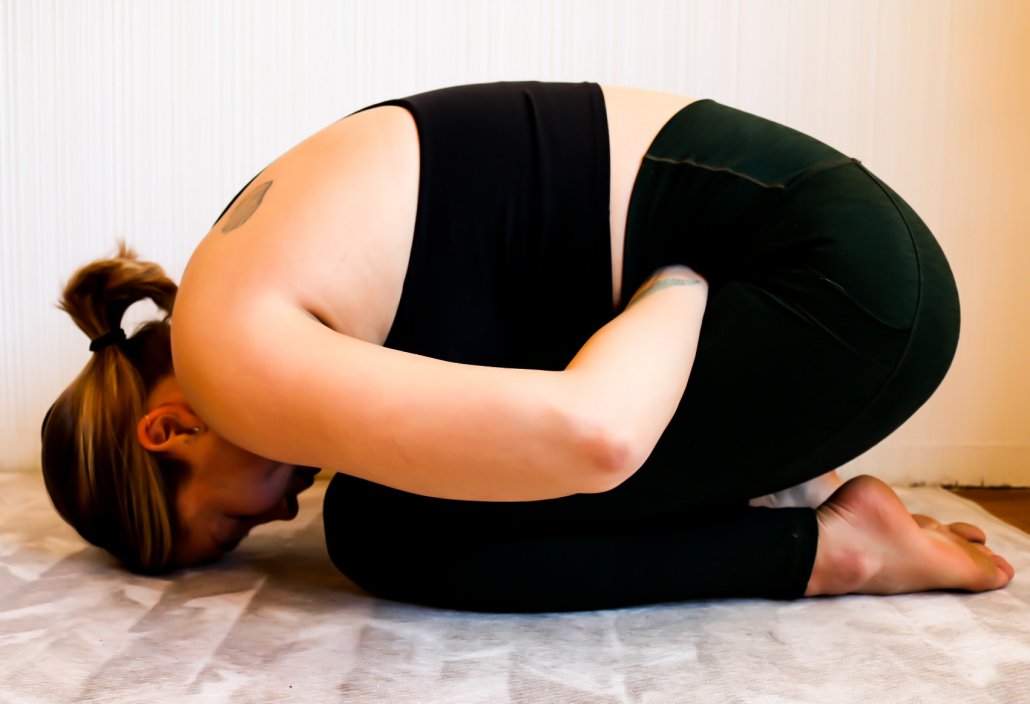
This pose is perfect for beginners looking for a restorative practice. It activates the parasympathetic nervous system triggering the “rest & digest” response, while calming your body.
- Bring your knees to the outside edges of your mat, and your big toes to touch behind you. Sit your hips down on your heels.
- Place your fists on either side of your navel with your palms faced toward you. Lower your torso down with your shoulders and elbows relaxed.
- Bring your forehead to rest against your mat so that you can relax your neck and spine. You may need to use a block or pillow under your forehead. You can also place a rolled towel under your knee creases to provide joint support.
- Keep your fists still or gently move them in circles, massaging your abdomen.
2. Seated Spinal Twist (Matsyendrasana)
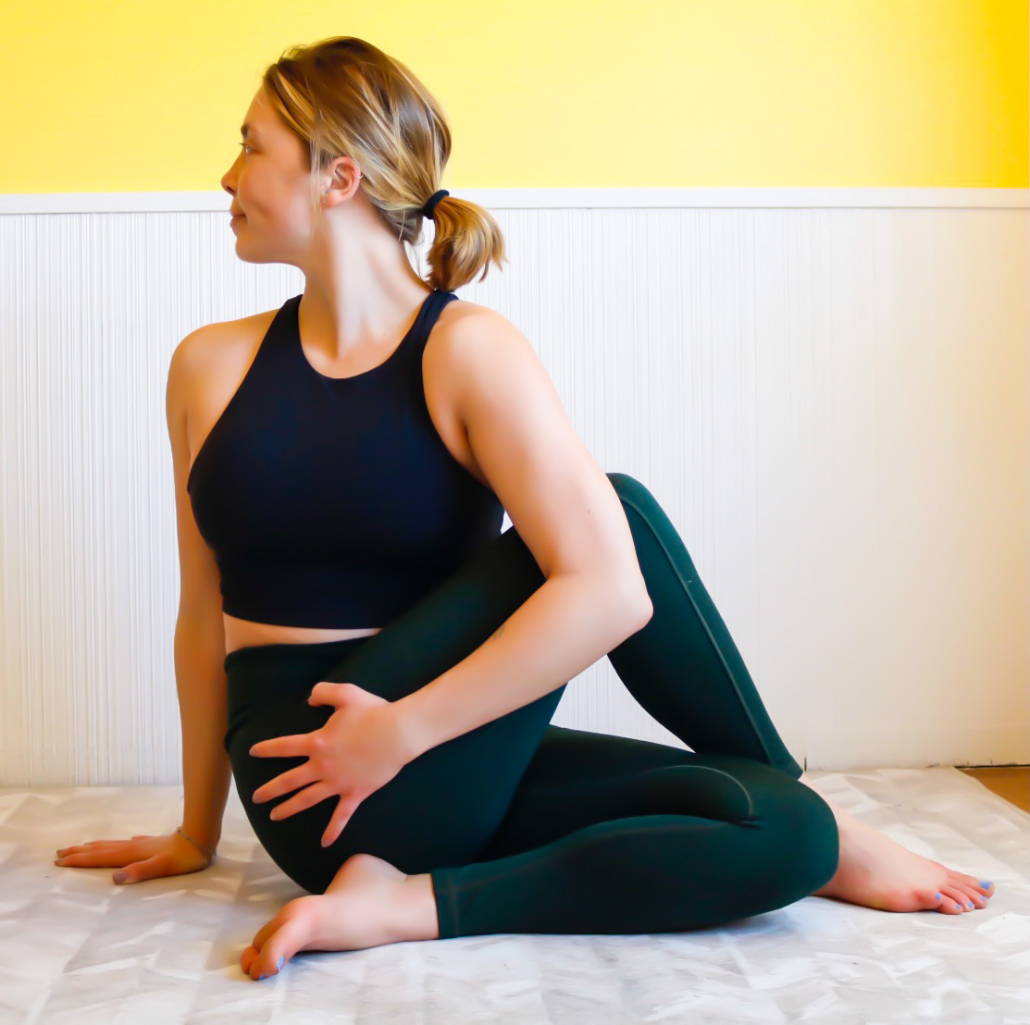
This pose is a two for one deal: it releases tension in your spine while moving nutrients through your organs.
- Sit tall with your pelvis rolled slightly forward. Bend both your left knee and place it on the ground, with your left heel close to your right glute.
- Bend your right knee and place your right foot over your left thigh so that the sole of your right foot is flat on the ground.
- Place your right palm behind your sacrum with your fingers facing away from you to use as a kickstand for your spine.
- With a tall spine, hug your right knee into your chest to twist to your right.
- Turn your head to the right and look over your right shoulder.
- Repeat on the opposite side.
3. Low Lunge Backbend Variation (Kapyasana)
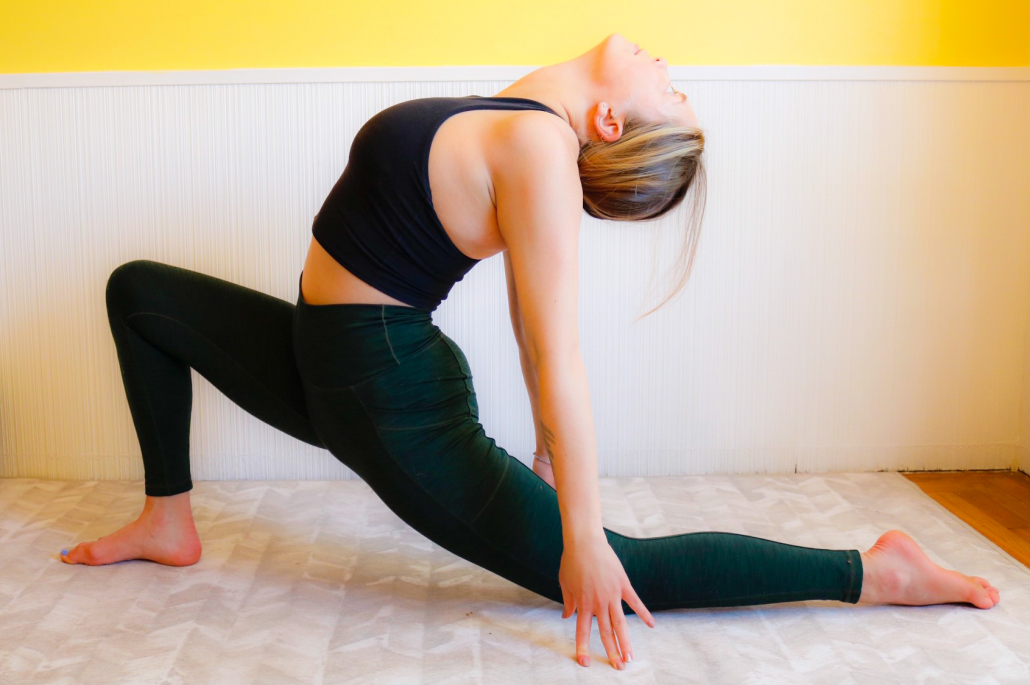
This pose stretches the front line of the body, creating space for your GI tract.
- Start in a low lunge position with your right knee forward and your left knee on the ground behind you.
- Press the top of your left foot down and squeeze your left glute for support as you press your hips forward, stretching the front of your left hip flexor.
- Keep your right knee stacked on top of your right foot and press into the big toe mound of your right foot.
- Place your palms on your lower back, fingers faced down or clasp them up above you with your index fingers released (i.e. Kali mudra).
- Lengthen the crown of your head tall to straighten your spine. Gently allow your head to tilt back behind you so that you are looking at the ceiling.
- With every breath continue to arch backwards and imagine pulling your organs up into your rib cage as you do this.
- You have the option of releasing your hands down toward the mat like in the image for support.
- Repeat on the opposite side.
4. Peacock (Mayurasana)
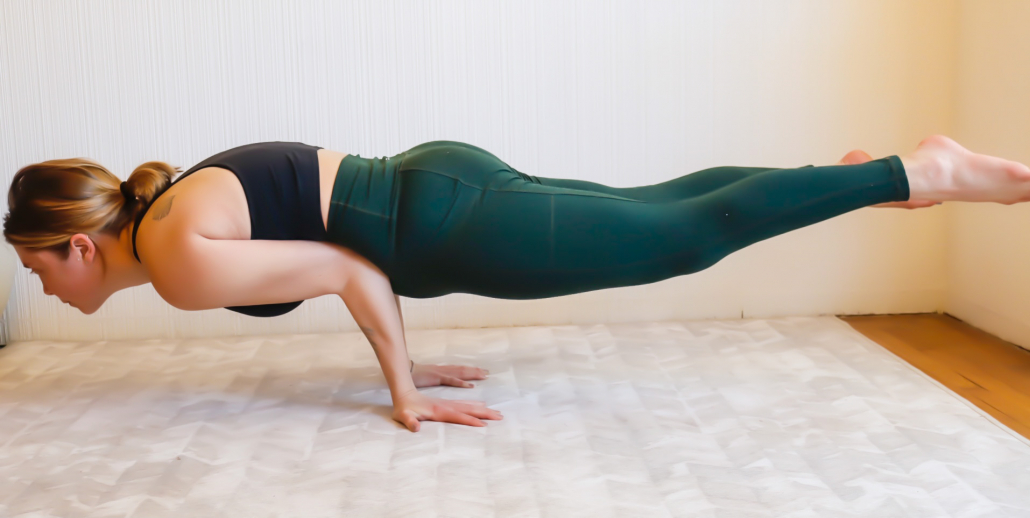
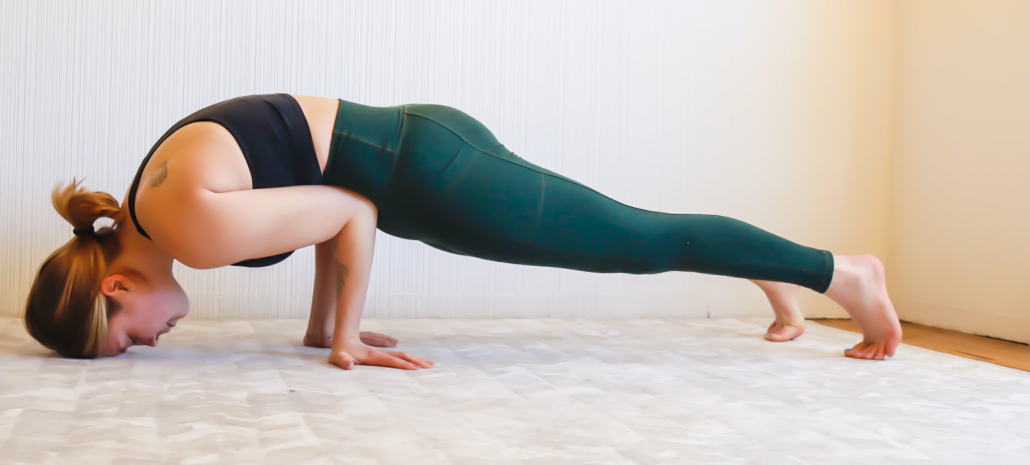
This is a more advanced posture that activates your stomach energy and strengthens your core.
- Start sitting on your heels with your knees apart. Lean forward and place your palms down on your mat with your fingers faced behind you and your forearms touching.
- Bend your elbows as you continue leaning forward and place your triceps in your low abdomen. Round your upper spine to get them there and engage your core for support.
- To begin, place your forehead on the mat in front of you. You can stay here in this position if you are still working towards lifting everything up.
- Straighten your knees and extend your legs behind you with your toes facing the floor. You have the option to stay here.
- Squeeze your glutes and thighs together so that your legs lift up. You can try lifting one leg off of the ground at a time.
- Engage the muscles in your back and continue shifting forward to lift your head up.
5. Garland Pose (Malasana)
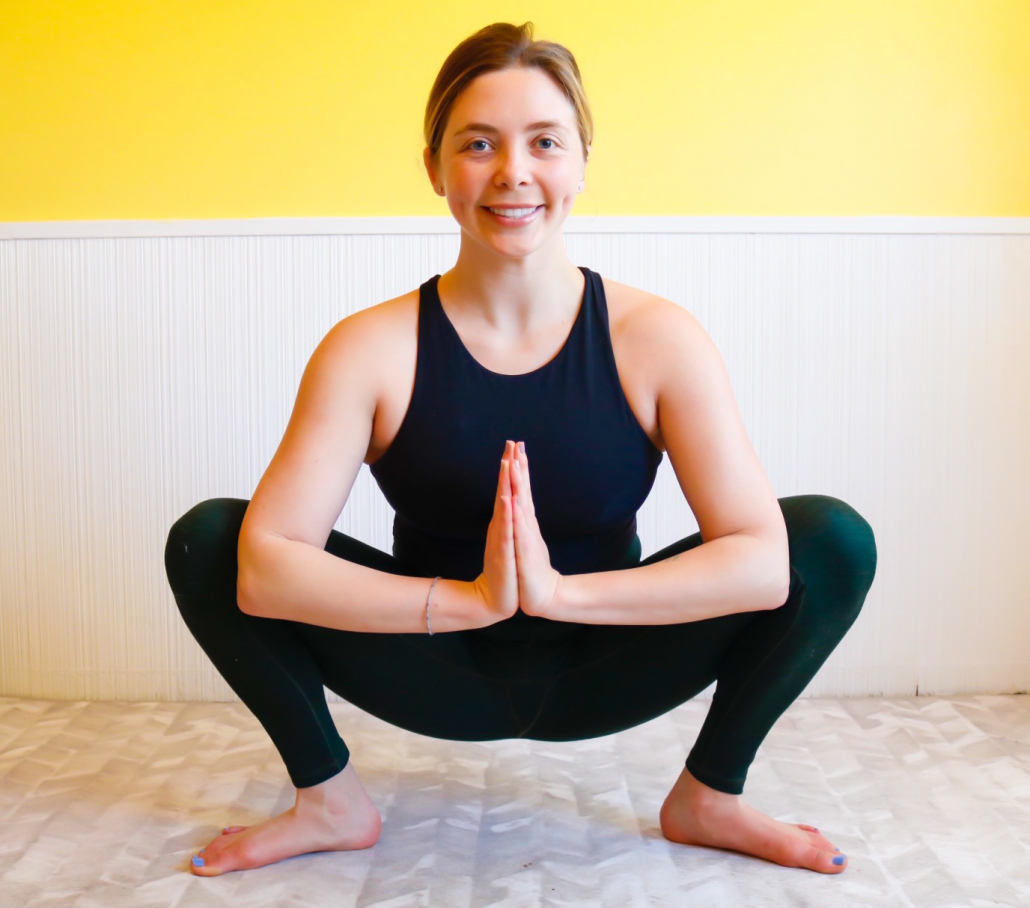
This gentle stretch may help alleviate bloating and support general digestion.
- Begin standing with your feet wider than hips width distance and your toes pointing out at a 45 degree angle. Bring your hands to a prayer position at the heart center.
- Slowly lower all the way down until your hips are below your knees.
- Use your elbows to press against your inner thighs so that you can broaden your chest.
- Lengthen your spine by reaching your tailbone down and the crown of your head high.
6. Reclined Wind Relieving (Pavanamuktasana)
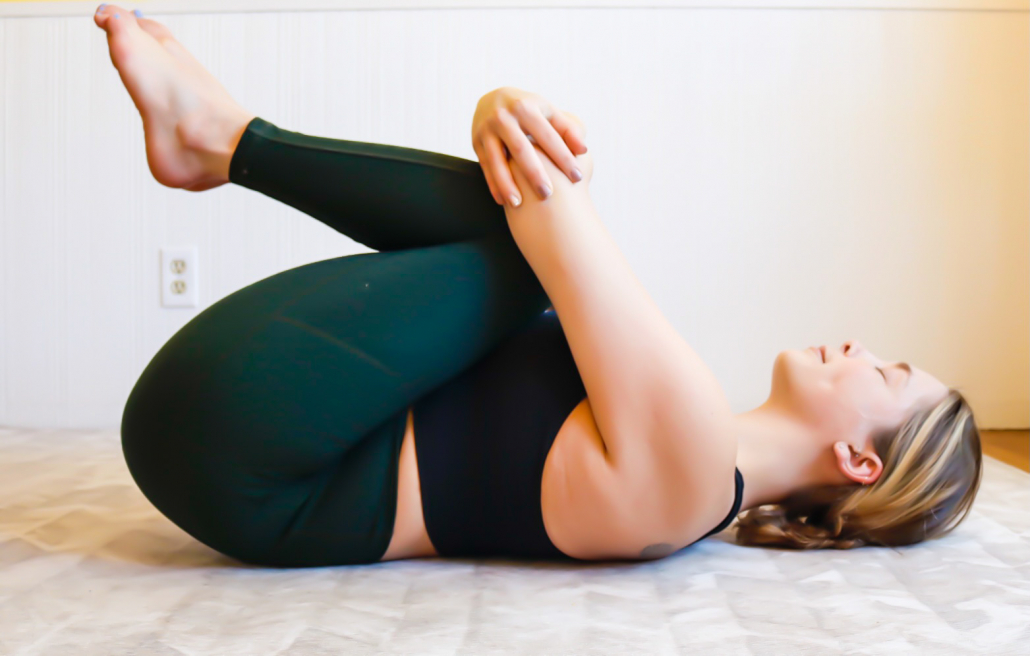
The pressure of your thighs against your abdomen gives your intestines a gentle massage that may result in air movement (hence the name).
- Begin lying down on your back. Bend your knees into your chest and wrap your arms around your shins.
- You can clasp your hands, hold opposite wrists, forearms, or elbows.
- Keep your lower spine, shoulders and the back of your head down on your mat.
- Breathe into your lower abdomen as you pull your thighs closer towards you.
Yoga for Digestion: The Outlook
Yoga for digestion helps with indigestion symptoms such as bloating, abdominal pain, constipation, and diarrhea. Practicing regularly builds awareness around lifestyle and eating habits that can trigger or soothe digestive issues. These six poses have also been shown to reduce stress, which plays a major role in indigestion.
If you struggle with digestion, know that you are not alone! Yoga for digestion is literally at your fingertips. So consider this an invitation to try on the role of scientist of your own life and experiment with these poses, tuning in to how they make you feel.
And if you’re interested in discovering more about what yoga practices are right for you, take this quiz!














